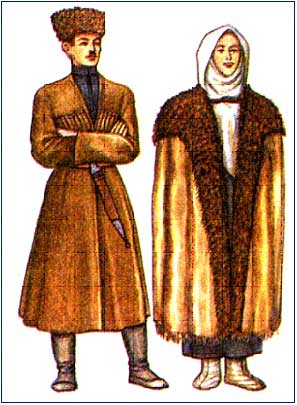 Dargins, the people in Russia, indigenous people of Dagestan. Number in Russia (together with the Kaitags which have entered into their structure and Kubachins) 353,3 thousand people, including in Dagestan 280,4 thousand people. Live also in Stavropol Krai (32,7 thousand people) and Kalmykia (12,9 thousand people). Total number is 365 thousand people. Language Dargwa nakhsko-Dagestan group of a North Caucasian family; the major dialects - akushinskiya (on its basis the literary language), tsudakharskiya, urakhinskiya (hyurkilinsky), sirkhinsky, mekeginsky, haydaksky, muerinsky, gubdensky, Qatar, Kubachi, chiragsky, megebsky. Russian is widespread. Writing on the basis of the Russian alphabet. Believers - the Sunni Muslims.
Dargins, the people in Russia, indigenous people of Dagestan. Number in Russia (together with the Kaitags which have entered into their structure and Kubachins) 353,3 thousand people, including in Dagestan 280,4 thousand people. Live also in Stavropol Krai (32,7 thousand people) and Kalmykia (12,9 thousand people). Total number is 365 thousand people. Language Dargwa nakhsko-Dagestan group of a North Caucasian family; the major dialects - akushinskiya (on its basis the literary language), tsudakharskiya, urakhinskiya (hyurkilinsky), sirkhinsky, mekeginsky, haydaksky, muerinsky, gubdensky, Qatar, Kubachi, chiragsky, megebsky. Russian is widespread. Writing on the basis of the Russian alphabet. Believers - the Sunni Muslims.The first certificates of the Arab authors on Kaytage and Zirikhgeran belong to the 9th century (in connection with events of 6-7 centuries) (Kubachi). The first mention ethnos Dargins - 15 eyelids. In the 14th century Islam was approved. By the beginning of the 19th eyelid in the territory of Dargins there was the Kaitag utsmiystvo, a number of the unions of rural communities (in mountain settlements), partially - the Tarkovsky shamkhalstvo. After entry of Dagestan into structure of Russia (1813) Dargins took part in liberating fight of mountaineers of Dagestan and Chechnya under the leadership of Shamil (1834-59), actively participated in anti-colonial revolt 1877. With 1921 Dargins as a part of the Dagestan ASSR, with 1991 - the Republic of Dagestan. In Soviet period the part of Dargins moved on the plain.
Since the 16th century there are three economic and cultural areas: 1) nizhnepredgorny (with part of the plain) - pashenny agriculture (barley, wheat, millet, corn, bean) and stationary cattle breeding (cattle); 2) the mid-mountain - pashenny agriculture and distant-pasture (fall) sheep breeding; 3) the mountainous - distant-pasture (spring) sheep breeding and pashenny agriculture.
 Are developed, generally in mountain areas, house crafts, especially wool processing (cloth, carpets, oriental carpets, knitted products), metal, a tree, a stone, skin. The weapon, jewelry from Kubachi, agricultural tools, the weapon - from Harbuk, blades from Amuzgi, a pottery (including irrigation) from Sulevkenta, cloth from Hadzhalmakhi, a carved stone from Sutbuk and Holaaya, wooden tools, utensils from Kaytaga, skin of tsudakharets, morocco and Gubden's women's shoes, etc. are most known. Widely the otkhodnichestvo practised. From the 2nd half of the 19th eyelid penetration of the commodity-money relations amplifies. The modern economy of Dargins is based on traditional occupations. In agriculture and cattle breeding new highly productive cultures and breeds are introduced. Mountain settlements of Dargins generally dense, terrasoobrazny, in the foothills moving more free, houses have yards. The most ancient dwelling single-chamber, with the center in the middle. The main type of the dwelling in mountains - two - and multi-storey buildings with a flat roof, in the foothills - two-storeyed and one-storeyed houses. For years of the Soviet power there were new public buildings and wider streets, houses (is more often two-storeyed, with a verandah) with iron and tile dvuskatny roofs.
Are developed, generally in mountain areas, house crafts, especially wool processing (cloth, carpets, oriental carpets, knitted products), metal, a tree, a stone, skin. The weapon, jewelry from Kubachi, agricultural tools, the weapon - from Harbuk, blades from Amuzgi, a pottery (including irrigation) from Sulevkenta, cloth from Hadzhalmakhi, a carved stone from Sutbuk and Holaaya, wooden tools, utensils from Kaytaga, skin of tsudakharets, morocco and Gubden's women's shoes, etc. are most known. Widely the otkhodnichestvo practised. From the 2nd half of the 19th eyelid penetration of the commodity-money relations amplifies. The modern economy of Dargins is based on traditional occupations. In agriculture and cattle breeding new highly productive cultures and breeds are introduced. Mountain settlements of Dargins generally dense, terrasoobrazny, in the foothills moving more free, houses have yards. The most ancient dwelling single-chamber, with the center in the middle. The main type of the dwelling in mountains - two - and multi-storey buildings with a flat roof, in the foothills - two-storeyed and one-storeyed houses. For years of the Soviet power there were new public buildings and wider streets, houses (is more often two-storeyed, with a verandah) with iron and tile dvuskatny roofs. Men's traditional wear of the all-Dagestan type - a shirt, trousers, бешмет, the Circassian, a burka, sheepskin fur coats capes, leather and felt footwear; the female - a dress shirt, wide or tight trousers, in a number of settlements a dress like архалука, various fur coats and leather footwear; headdress - чухта (I had local options) and a cover, richly trimmed with silver jewelry and embroideries.
Men's traditional wear of the all-Dagestan type - a shirt, trousers, бешмет, the Circassian, a burka, sheepskin fur coats capes, leather and felt footwear; the female - a dress shirt, wide or tight trousers, in a number of settlements a dress like архалука, various fur coats and leather footwear; headdress - чухта (I had local options) and a cover, richly trimmed with silver jewelry and embroideries.Traditional food - flour and meat-and-milk, and also vegetables, fruit, greens, berries.
Комментариев нет:
Отправить комментарий